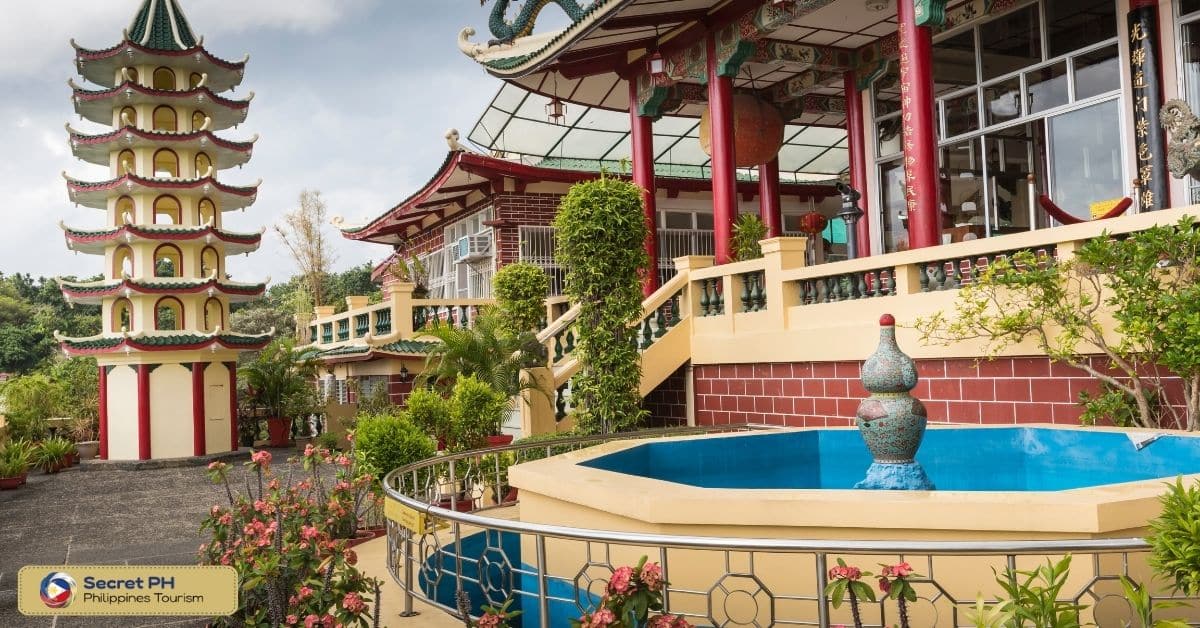Philippine Taoism is a unique syncretism that blends Chinese Taoist beliefs with indigenous Filipino traditions. It incorporates elements such as ancestor veneration, animism, and Catholicism, resulting in a distinct religious practice. This syncretism reflects the historical and cultural interactions between China and the Philippines and the adaptability of Taoism to local contexts.
In this blog, we will explore the origins of Philippine Taoism, its key doctrines, and how it has evolved over time. So, hold on to your hats, as we embark on a journey through the colorful tapestry of this rich and vibrant spiritual tradition.

Philippine Taoism
Philippine Taoism is a fascinating topic that explores its rich history. The philosophy, and culture of Taoism in the Philippines. This ancient Chinese philosophy has been practiced for thousands of years. It has played a significant role in shaping the spiritual beliefs of many people. The fusion of traditional Taoism with Philippine culture has created a unique blend that is both captivating and intriguing.
Taoism in the Philippines is often represented through deities and mythology. Its practice includes the use of herbal medicine, meditation, and feng shui. For those interested in learning more, exploring the traditions and practices of Philippine Taoism is a rewarding journey. This offers insight and understanding into a fascinating aspect of Filipino culture.

Historical Background
Chinese migration to the Philippines dates back to the 9th century. Initially, traders and merchants from southern China arrived and established settlements in the islands for trade purposes. During the Spanish colonization in the 16th century, more Chinese immigrants arrived. Particularly in Manila, they work in various industries such as agriculture, weaving, and retail. Many of them achieved economic success. Some even held influential positions in the Spanish colonial government.
In the early 20th century, Chinese immigrants continued to flock to the Philippines. Despite the island nation’s independence from Spain and the subsequent American occupation. Today, the Chinese-Filipino community is a significant part of the Philippines’ culture and history. Their contributions to various fields, especially in business, have played a vital role in the country’s development.
The arrival of Taoism in the Philippines
Taoism, a belief system that originated in China, made its way to the Philippines. It is through various Chinese merchants and traders. Its teachings on finding balance in life and connection to nature resonated with Filipinos. Those who value harmony and respect towards their environment. Taoist principles also influenced the practice of Chinese traditional medicine. Then became popularized in the Philippines as a holistic approach to health and wellness.
Today, Taoism continues to have a presence in the Philippines. They have numerous Taoist temples and shrines scattered across the country. Its impact can be seen through various cultural practices, festivals, and traditions. And have been passed down through generations. The arrival of Taoism in the Philippines has left a lasting legacy. This contributed to the diverse cultural landscape of the country.

Development of Philippine Taoism
Philippine Taoism has a long and fascinating history that dates back to the early Chinese settlers who migrated to the islands. This ancient Chinese philosophy fused with the indigenous beliefs of the Philippines to form a unique blend of Taoism. It has thrived in the country for centuries. The development of this form of Taoism has been shaped by a range of factors. This includes colonial influences and the spread of the religion through Chinese immigrant communities.
Also, the evolution of Taoist practices over time. Today, Philippine Taoism continues to flourish. Its iconic temples and festivals draw visitors from all over the world. As the country continues to evolve and modernize. It remains to be seen how this rich cultural tradition will continue to shape and adapt to the changing times.

Chinese Taoism vs Philippine Taoism
Taoism is a philosophical and religious tradition that originated in China and has spread across the world. While most people are familiar with Chinese Taoism. Many may not be aware of the different versions of Taoism that exist, such as Philippine Taoism. Although they share some similarities, such as the concept of Tao or the way. There are distinct differences between these two traditions.
Similarities and differences
Taoism is a philosophical and religious tradition that originated in China and has spread to many other parts of the world. While Chinese Taoism is the most well-known and widely practiced form, there are also variations of Taoism found in other cultures, such as Philippine Taoism. In this table, we will explore the similarities and differences between Chinese Taoism and Philippine Taoism.
Similarities:
| Aspect | Chinese Taoism | Philippine Taoism |
| Beliefs | Both believe in the Tao, Yin-Yang and the Five Elements | Both believe in the Tao, Yin-Yang, and the Five Elements |
| Deities | Both worship a pantheon of gods and goddesses | Both worship a pantheon of gods and goddesses |
| Practices | Both use meditation, divination, and rituals to connect with the divine | Both use meditation, divination, and rituals to connect with the divine |
| Ethics | Both emphasize living in harmony with nature, cultivating inner virtue, and practicing selflessness | Both emphasize living in harmony with nature, cultivating inner virtue, and practicing selflessness |
Differences:
| Aspect | Chinese Taoism | Philippine Taoism |
| Origins | Originated in China around 2000 years ago | Has roots in indigenous Philippine beliefs and Chinese Taoism |
| Religious Status | Recognized as an official religion in China | Not recognized as an official religion in the Philippines |
| Language | Texts are primarily in Chinese | Texts are in both Chinese and Tagalog |
| Practices | Emphasizes tai chi, feng shui, and qigong | Emphasizes the use of amulets, talismans, and charms |
Influence of Filipino Culture on Taoist Practices
The influence of Filipino culture on Taoist practices can be seen through various traditions and rituals. Taoism has been practiced in the Philippines for centuries and has been heavily influenced by the country’s diverse culture. The incorporation of traditional Filipino beliefs and customs has resulted in a uniquely Filipino Taoism.
An example of this would be the use of herbs and plants in Taoist healing rituals, which have been heavily influenced by Filipino herbal medicine practices. The Taoist concept of Yin and Yang has also been blended with Filipino beliefs in balancing energies to achieve optimal health and well-being.

Syncretic Practices of Philippine Taoism
Syncretic Practices of Philippine Taoism are a fascinating subject that deserves exploration. With its roots in ancient Chinese philosophy and religion, Taoism is a spiritual practice that emphasizes living in harmony with the natural order of things.
In the Philippines, Taoism has blended with local folk beliefs and traditions, resulting in a unique syncretic tradition. This hybrid form of Taoism encompasses a wide range of practices, including the veneration of ancestors and spirits, divination rituals, and the use of amulets and charms.

- Ancestral worship – Ancestral worship is a syncretic practice of Philippine Taoism that holds high regard for ancestors. It plays a significant role in the daily life of the Taoist community, where the living honor and seek guidance from their deceased loved ones. This practice has its roots in ancient Chinese culture and is perceived as a way to connect with the spiritual realm. It is also believed that ancestral spirits have a strong influence on the life of their descendants and can intercede on their behalf to bring good fortune.
- Feng shui – Feng shui is a syncretic practice rooted in Philippine Taoism that aims to harmonize individuals with their environment. It involves arranging objects, furniture, and spaces to achieve ideal energy flow and balance. Feng shui practitioners believe that proper placement can improve various aspects of one’s life, such as career, health, and relationships. This centuries-old tradition continues to be influential in modern times, inspiring people to create peaceful and balanced surroundings.
- Fortune-telling – Fortune-telling has been an integral part of Philippine Taoism, a syncretic religion that blends ancient Chinese beliefs with local Filipino customs. Practitioners, known as Taoists, use a variety of divination techniques to interpret the future. These include reading tarot cards, feng shui, and palmistry. They believe that by examining a person’s energies, they can predict their future and provide guidance. Philippine Taoism emphasizes balance and harmony, and Taoists strive to help people find their path in life through their practice.
- Taoist festivals and rituals – Taoist festivals and rituals are integral parts of Philippine Taoism, which is a syncretic practice combining elements of Taoism, Confucianism, and Buddhism. These festivals and rituals are often held in honor of various deities and ancestors, with each celebration having its own unique traditions and customs. During these events, followers engage in various activities such as offerings of incense and food, dances, and processions. Through these rituals, devotees seek to establish a deeper connection with their deities, amplifying their spirituality, and aligning their lives with the principles of Taoism.
Challenges and Opportunities
Taoism has been present in the Philippines for centuries, but it still faces various challenges. One of the biggest struggles is the limited number of Taoist practitioners, which compromises their ability to sustain the faith’s practices and traditions. Additionally, there is a lack of resources and support from the government for Taoism in the country, which hinders its growth and expansion.
Meanwhile, the popularization of other religions has also affected the community despite efforts to preserve Taoism’s unique cultural identity. Despite these challenges, Taoist organizations and practitioners continue to persevere and strive for the advancement of their beliefs and traditions. They remain determined to educate the public and promote greater understanding and awareness of this faith’s rich heritage and practices.
Opportunities for growth and development
Taoism has been practiced in the Philippines for centuries, but it is not without its challenges. Despite the long history and rich tradition surrounding this philosophy, many Taoist communities in the Philippines struggle to find opportunities for growth and development. The challenge is amplified by the lack of government support and resources, which limits the ability of Taoism leaders to promote and preserve the philosophy.
However, this challenge also creates an opportunity for the community to come together and work towards a common goal. By collaborating with other religious and cultural groups, the Taoist community can identify ways to overcome these hurdles and create a brighter future for their practice. These opportunities for growth and development will not only benefit the Taoist community but also contribute to the cultural heritage and diversity of the Philippines as a whole.

In Conclusion
The Unique Syncretism of Philippine Taoism showcases the country’s diverse culture through the blending of Chinese and Filipino beliefs. This syncretism is not only a mixture of beliefs, but also a reflection of historical and social connections between China and the Philippines. The cultural fusion of Taoism in the Philippines started in the early 8th century, with the arrival of Chinese traders who introduced Taoist teachings and practices into the local communities.
Today, Taoism is ingrained in Filipino culture and is celebrated through various festivals throughout the year. The beauty of this unique syncretism lies in the way that it highlights the interconnectedness of different cultures, as well as the ability of a culture to absorb and integrate foreign elements while maintaining its identity.








